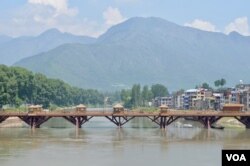October is usually high tourist season in Indian Kashmir, but Imran Dar, who takes visitors for a boat ride in the famous Dal Lake, returned home empty handed on many days last month.
That is no surprise. Wracked with renewed unrest in the past 18 months, the number of visitors to Kashmir this year plunged.
Dar hopes next year will be better. “There should be normalcy, tourists should come. Some years were very good, but this year was very bad,” says Dar, wistfully recalling a decade when relative peace brought a flood of tourists into the picturesque Himalayan region. “Let’s see what the government does.”
Can the Kashmiri boatman look forward to rowing more people next summer?
Last week, the federal Hindu nationalist government took a key step toward reconciliation in India’s most alienated region by appointing a representative, Dineshwar Sharma, to lead a dialogue with all parties.
“I think it is a huge breakthrough, that the government has recognized that they really need to start talking to people,” says Radha Kumar, an academician who undertook the same role in Kashmir under the previous government in 2010.
Calling the task “hugely daunting”, she says, “We are at a point of alienation I could not have even dreamed of 15 years ago.”
Autonomy or independence
But in the Muslim-majority region that has witnessed a resurgence of demands for independence from India, there is widespread skepticism whether the newly-appointed representative will be able to cool anti-India sentiment or douse anger that has run high since the killing of a local militant leader, Burhan Wani last July.
The decision to reach out to the state is a concession from a hard line government that had indicated dialogue was not possible while violent protests and militant attacks wracked the region. It comes after Prime Minister Narendra Modi stressed the need for engagement during an Independence Day address in August, saying that not “bullets and abuses” but only “hugs” for Kashmiris could bring peace.
The government says the former chief of the intelligence bureau, who is familiar with the region, will lead talks to understand the aspirations of Kashmiris.
Political analysts in Kashmir say that people in the region had been “craving” such a dialogue. However, they point to worrying signals since Sharma’s appointment that he may not be able to defuse tensions.
Prominent leaders of the region’s main separatist alliance in Kashmir have refused to join the talks, dismissing them as an “exercise in futility” and a “tactic” to buy time and fend off international pressure. They said Sharma’s statement that he is coming to restore peace rather than address the Kashmir dispute limits the scope of his engagement.
The refusal of the Hurriyat leaders to join the talks is a setback, according to the editor of the Rising Kashmir newspaper, Shujaat Bukhari. “The dialogue needs to be done with the people who actually represent the voice of dissent in Kashmir. I don’t think it is going that way.” He says it is pointless talking to local parties who are in sync with New Delhi’s position that Kashmir is not disputed territory.
Increasing militancy
There have been longstanding demands in the Himalayan region, which is claimed by both India and Pakistan, for freedom or more autonomy. Those calls had abated after an armed insurgency that wracked the region in the 1990’s ebbed, but slogans for “azadi” (freedom) began ringing out loudly again last year in the streets of its summer capital, Srinagar. Worrying for New Delhi, many young people were among the anti-India demonstrators, including hundreds of angry students.
Security forces have also estimated that more local young people are joining the ranks of militants in the past two years.
After his appointment, Sharma said that reaching out to young people would be his special focus because the top priority in Kashmir is to "deradicalize" the youth and militants and prevent the territory from turning into a Syria of India.
That statement did not go down well in Kashmir, according to editor Bukhari, who dismisses any comparison between Kashmir and Syria, where an anti-regime uprising spiraled into a civil war. “It is not a remote chance,” he says.
Observers say that signals from the government that more autonomy for Kashmir is not on the table will also make it difficult to make significant headway. “It does not help when the government says that they consider autonomy to be secessionist and they wont even consider it, ” according to Radha Kumar.
But as Sharma prepares to initiate the talks, he sounds an optimistic note telling reporters his objective will be to find “long-term normalcy” in the state, “one which does not fizzle away quickly.”
Twenty-eight -year-old boatman Dar, who has witnessed much tumult as he grew up in the insurgency-wracked region, can only keep his fingers crossed. “I have seen a lot. What more is there to see? But OK, I will keep hope that something good will happen,” he shrugs.











